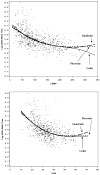Lower extremity strength and power are associated with 400-meter walk time in older adults: The InCHIANTI study
- PMID: 17167161
- PMCID: PMC2668162
- DOI: 10.1093/gerona/61.11.1186
Lower extremity strength and power are associated with 400-meter walk time in older adults: The InCHIANTI study
Abstract
Background: It has been suggested that lower extremity muscle power is more important for physical function in older adults compared to strength, and that there is a nonlinear relationship between power or strength and physical function that might be indicative of a threshold above which the association between muscle function and physical function is no longer evident. This study examined the association between lower extremity strength or power with the time to complete a 400-meter walk, and attempted to identify thresholds within the relationship.
Methods: A cross-sectional analysis of a sample of 384 females and 336 males aged > or = 65 years from the InCHIANTI study ("Invecchiare in Chianti," i.e., Aging in the Chianti Area) was conducted. Measures included 400-meter walk time, lower extremity strength and power, comorbidities, and sociodemographic variables (age, gender, height, education, cognitive function, depression).
Results: Linear regression models showed that both lower extremity strength and power were significant predictors of 400-meter walk time, although power explained marginally more of the variance in 400-meter walk time. Quadratic models of lower extremity strength and power fit the data slightly better than the linear models. Regardless of gender, comorbidities, or normalization scheme for strength and power, the curvilinear form of the relationship between strength or power and 400-meter walk time remained the same.
Conclusions: Lower extremity muscle strength and power are both important predictors of the 400-meter walk time. Although curvilinear relationships existed between muscle strength and power and the 400-meter walk time, the data do not indicate a clear threshold for either strength or power above which the performance in the 400-meter walk test plateaus.
Figures
References
-
- International Classification of Functioning, Disability and Health: ICF 2001. Geneva, Switzerland: World Health Organization; 2001.
-
- Fried LP, Bandeen-Roche K, Chaves PH, Johnson BA. Preclinical mobility disability predicts incident mobility disability in older women. J Gerontol A Biol Sci Med Sci. 2000;55A:M43–M52. - PubMed
-
- Lan TY, Melzer D, Tom BD, Guralnik JM. Performance tests and disability: developing an objective index of mobility-related limitation in older populations. J Gerontol A Biol Sci Med Sci. 2002;57A:M294–M301. - PubMed
-
- Fried LP, Guralnik JM. Disability in older adults: evidence regarding significance, etiology, and risk. J Am Geriatr Soc. 1997;45:92–100. - PubMed
-
- Sayers SP, Brach JS, Newman AB, Heeren TC, Guralnik JM, Fielding RA. Use of self-report to predict ability to walk 400 meters in mobility-limited older adults. J Am Geriatr Soc. 2004;52:2099–2103. - PubMed
Publication types
MeSH terms
Grants and funding
LinkOut - more resources
Full Text Sources
Medical


